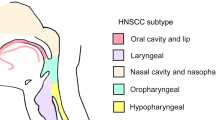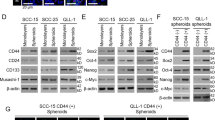Abstract
Head and neck squamous cell carcinoma (HNSCC) remains a significant public health problem, accounting for over 5% of all cancer-related deaths, and these deaths primarily result from metastatic disease. The molecular processes involved in HNSCC pathogenesis and progression are poorly understood, and here we present experimental evidence for a direct role of the cell surface receptor tyrosine kinase, TrkB, in HNSCC tumor progression. Using immunohistochemical analysis and transcriptional profiling of archival HNSCC tumor specimens, we found that TrkB and its secreted ligand, brain-derived neurotrophic factor (BDNF), are expresses in greater than 50% of human HNSCC tumors, but not in normal upper aerodigestive tract (UADT) epithelia. Studies with HNSCC cell lines reveal that in vitro stimulation with BDNF, the ligand for TrkB, upregulates the migration and invasion of HNSCC cells, and both transient and stable suppressions of TrkB result in significant abrogation of constitutive and ligand-mediated migration and invasion. Furthermore, enforced overexpression of TrkB results in altered expression of molecular mediators of epithelial-to-mesenchymal transition (EMT), including downregulation of E-cadherin and upregulation of Twist. Using an in vivo mouse model of HNSCC, we were able to show that downregulation of TrkB suppresses tumor growth. These results directly implicate TrkB in EMT and the invasive behavior of HNSCC, and correlate with the in vivo overexpression of TrkB in human HNSCC. Taken together, these data suggest that the TrkB receptor may be a critical component in the multi-step tumor progression of HNSCC, and may be an attractive target for much needed new therapies for this disease.
This is a preview of subscription content, access via your institution
Access options
Subscribe to this journal
Receive 50 print issues and online access
$259.00 per year
only $5.18 per issue
Buy this article
- Purchase on Springer Link
- Instant access to full article PDF
Prices may be subject to local taxes which are calculated during checkout







Similar content being viewed by others
References
Arias AM . (2001). Epithelial mesenchymal interactions in cancer and development. Cell 105: 425–431.
Armistead P, Salganick J, Roh J, Steinert D, Patel S, Munsell M et al. (2007). Expression of receptor tyrosine kinases and apoptotic molecules in rhabdomyosarcoma. Cancer 110: 2293–2303.
Bardelli A, Parsons DW, Silliman N, Ptak J, Szabo S, Saha S et al. (2003). Mutational analysis of the tyrosine kinome in colorectal cancers. Science 300: 949.
Bonner JA, Harari PM, Giralt J, Azarnia N, Shin DM, Cohen RB et al. (2006). Radiotherapy plus cetuximab for squamous-cell carcinoma of the head and neck. N Engl J Med 354: 567–578.
Chao MV, Lee FS . (2004). Neurotrophin survival signaling mechanisms. J Alzheimers Dis 6: S7–S11.
Cheng GZ, Chan J, Wang Q, Zhang W, Sun CD, Wang L-H . (2007). Twist transcriptionally up-regulates AKT2 in breast cancer cells leading to increased migration, invasion, and resistance to paclitaxel. Cancer Res 67: 1979–1987.
Christofori G . (2006). New signals from the invasive front. Nature 441: 444–450.
Ding L, Getz G, Wheeler DA, Mardis ER, McLellan MD, Cibulskis K et al. (2008). Somatic mutations affect key pathways in lung adenocarcinoma. Nature 455: 1069–1075.
Douma S, Van Laar T, Zevenhoven J, Meuwissen R, Van Garderen E, Peeper DS . (2004). Suppression of anoikis and induction of metastasis by the neurotrophic receptor TrkB. Nature 430: 1034–1039.
Eggert A, Grotzer MA, Ikegaki N, Liu XG, Evans AE, Brodeur GM . (2002). Expression of the neurotrophin receptor TrkA down-regulates expression and function of angiogenic stimulators in SH-SY5Y neuroblastoma cells. Cancer Res 62: 1802–1808.
Eggert A, Grotzer MA, Ikegaki N, Zhao H, Cnaan A, Brodeur GM et al. (2001). Expression of the neurotrophin receptor TrkB is associated with unfavorable outcome in Wilms’ tumor. J Clin Oncol 19: 689–696.
Eggert A, Ikegaki N, Liu XG, Brodeur GM . (2000). Prognostic and biological role of neurotrophin-receptor TrkA and TrkB in neuroblastoma. Klin Padiatr 212: 200–205.
Geiger TR, Peeper DS . (2007). Critical role for TrkB kinase function in anoikis suppression, tumorigenesis, and metastasis. Cancer Res 67: 6221–6229.
Han G, Lu SL, Li AG, He W, Corless CL, Kulesz-Martin M et al. (2005). Distinct mechanisms of TGF-beta1-mediated epithelial-to-mesenchymal transition and metastasis during skin carcinogenesis. J Clin Invest 115: 1714–1723.
Ho R, Eggert A, Hishiki T, Minturn JE, Ikegaki N, Foster P et al. (2002). Resistance to chemotherapy mediated by TrkB in neuroblastomas. Cancer Res 62: 6462–6466.
Hoot KE, Lighthall J, Han G, Lu SL, Li A, Ju W et al. (2008). Keratinocyte-specific Smad2 ablation results in increased epithelial–mesenchymal transition during skin cancer formation and progression. J Clin Invest 118: 2722–2732.
Huang EJ, Reichardt LF . (2003). Trk receptors: roles in neuronal signal transduction. Annu Rev Biochem 72: 609–642.
Jaboin J, Kim CJ, Kaplan DR, Thiele CJ . (2002). Brain-derived neurotrophic factor activation of TrkB protects neuroblastoma cells from chemotherapy-induced apoptosis via phosphatidylinositol 3′-kinase pathway. Cancer Res 62: 6756–6763.
Jemal A, Siegel R, Ward E, Murray T, Xu J, Thun MJ . (2007). Cancer Statistics, 2007. CA Cancer J Clin 57: 43–66.
Karamouzis MV, Grandis JR, Argiris A . (2007). Therapies directed against epidermal growth factor receptor in aerodigestive carcinomas. JAMA 298: 70–82.
Ketterer K, Rao S, Friess H, Weiss J, Buchler MW, Korc M . (2003). Reverse transcription-PCR analysis of laser-captured cells points to potential paracrine and autocrine actions of neurotrophins in pancreatic cancer. Clin Cancer Res 9: 5127–5136.
Klein R, Lamballe F, Bryant S, Barbacid M . (1992). The trkB tyrosine protein kinase is a receptor for neurotrophin-4. Neuron 8: 947–956.
Kupferman ME, Jayakumar A, Zhou G, Xie T, Dakak-Yazici Y, Zhao M et al. (2009). Therapeutic suppression of constitutive and inducible JAK/STAT activation in head and neck squamous cell carcinoma. J Exp Ther Oncol 8: 117–127.
Kupferman ME, Myers JN . (2006). Molecular biology of oral cavity squamous cell carcinoma. Otolaryngol Clin North Am 39: 229–247.
Li Z, Zhang J, Liu Z, Woo CW, Thiele CJ . (2007). Downregulation of Bim by brain-derived neurotrophic factor activation of TrkB protects neuroblastoma cells from paclitaxel but not etoposide or cisplatin-induced cell death. Cell Death Differ 14: 318–326.
Liang C-C, Park AY, Guan J-L . (2007). In vitro scratch assay: a convenient and inexpensive method for analysis of cell migration in vitro. Nat Protoc 2: 329–333.
Lu C-H, Wyszomierski SL, Tseng L-M, Sun M-H, Lan K-H, Neal CL et al. (2007). Preclinical testing of clinically applicable strategies for overcoming trastuzumab resistance caused by PTEN deficiency. Clin Cancer Res 13: 5883–5888.
Luikart BW, Zhang W, Wayman GA, Kwon CH, Westbrook GL, Parada LF . (2008). Neurotrophin-dependent dendritic filopodial motility: a convergence on PI3K signaling. J Neurosci 28: 7006–7012.
Martens LK, Kirschner KM, Warnecke C, Scholz H . (2007). Hypoxia-inducible factor-1 (HIF-1) is a transcriptional activator of the TrkB neurotrophin receptor gene. J Biol Chem 282: 14379–14388.
Matsumoto K, Wada RK, Yamashiro JM, Kaplan DR, Thiele CJ . (1995). Expression of brain-derived neurotrophic factor and p145TrkB affects survival, differentiation, and invasiveness of human neuroblastoma cells. Cancer Res 55: 1798–1806.
Miknyoczki SJ, Lang D, Huang L, Klein-Szanto AJ, Dionne CA, Ruggeri BA . (1999). Neurotrophins and Trk receptors in human pancreatic ductal adenocarcinoma: expression patterns and effects on in vitro invasive behavior. Int J Cancer 81: 417–427.
Nakamura K, Martin KC, Jackson JK, Beppu K, Woo CW, Thiele CJ . (2006). Brain-derived neurotrophic factor activation of TrkB induces vascular endothelial growth factor expression via hypoxia-inducible factor-1alpha in neuroblastoma cells. Cancer Res 66: 4249–4255.
Nakashima T, Pak SC, Silverman GA, Spring PM, Frederick MJ, Clayman GL . (2000). Genomic cloning, mapping, structure and promoter analysis of HEADPIN, a serpin which is down-regulated in head and neck cancer cells. Biochim Biophys Acta 1492: 441–446.
O'Donnell RK, Kupferman M, Wei SJ, Singhal S, Weber R, O′Malley B et al. (2005). Gene expression signature predicts lymphatic metastasis in squamous cell carcinoma of the oral cavity. Oncogene 24: 1244–1251.
Parkin DM, Bray F, Ferlay J, Pisani P . (2005). Global Cancer Statistics, 2002. CA Cancer J Clin 55: 74–108.
Pearse RN, Swendeman SL, Li Y, Rafii D, Hempstead BL . (2005). A neurotrophin axis in myeloma: TrkB and BDNF promote tumor-cell survival. Blood 105: 4429–4436.
Smit MA, Geiger TR, Song J-Y, Gitelman I, Peeper DS . (2009). A Twist–Snail axis critical for TrkB-induced EMT-like transformation, anoikis resistance and metastasis. Mol Cell Biol 29: 3722–3737.
Thiery JP . (2002). Epithelial–mesenchymal transitions in tumour progression. Nat Rev Cancer 2: 442–454.
Yang MH, Chang SY, Chiou SH, Liu CJ, Chi CW, Chen PM et al. (2006). Overexpression of NBS1 induces epithelial-mesenchymal transition and co-expression of NBS1 and Snail predicts metastasis of head and neck cancer. Oncogene 26: 1459–1467.
Yigitbasi OG, Younes MN, Doan D, Jasser SA, Schiff BA, Bucana CD et al. (2004). Tumor cell and endothelial cell therapy of oral cancer by dual tyrosine kinase receptor blockade. Cancer Res 64: 7977–7984.
Zhou G, Xie TX, Zhao M, Jasser SA, Younes MN, Sano D et al. (2008). Reciprocal negative regulation between S100A7/psoriasin and beta-catenin signaling plays an important role in tumor progression of squamous cell carcinoma of oral cavity. Oncogene 27: 3527–3538.
Acknowledgements
We thank S Jasser, MS, for technical assistance, T Astin for administrative assistance and X Wu, PhD, for critical review of the paper. This study was supported by the following funding sources: American Head and Neck Society; Young Investigator Award (MEK); Head and Neck SPORE Program-Career Development Award, MDACC (MEK); and the MD Anderson Cancer Center Physician-Scientist Program (MEK). NIH Cancer Center Support Grant CA16672 (MDACC) and Grant K08 DE019185 from the NIDCR (MEK).
Author information
Authors and Affiliations
Corresponding author
Additional information
Supplementary Information accompanies the paper on the Oncogene website (http://www.nature.com/onc)
Supplementary information
Rights and permissions
About this article
Cite this article
Kupferman, M., Jiffar, T., El-Naggar, A. et al. TrkB induces EMT and has a key role in invasion of head and neck squamous cell carcinoma. Oncogene 29, 2047–2059 (2010). https://doi.org/10.1038/onc.2009.486
Received:
Revised:
Accepted:
Published:
Issue Date:
DOI: https://doi.org/10.1038/onc.2009.486
Keywords
This article is cited by
-
Prognostic DNA mutation and mRNA expression analysis of perineural invasion in oral squamous cell carcinoma
Scientific Reports (2024)
-
Transcriptomic alterations underlying metaplasia into specific metaplastic components in metaplastic breast carcinoma
Breast Cancer Research (2023)
-
Human Wharton’s Jelly Mesenchymal Stem Cell Secretome Modifies the Processes of Neuroprotection and Epithelial-Mesenchymal Transition in Retinal Pigment Epithelium at Transcriptional Level
Molecular Biology Reports (2023)
-
BDNF and its signaling in cancer
Journal of Cancer Research and Clinical Oncology (2023)
-
The role of the ZEB1–neuroinflammation axis in CNS disorders
Journal of Neuroinflammation (2022)



